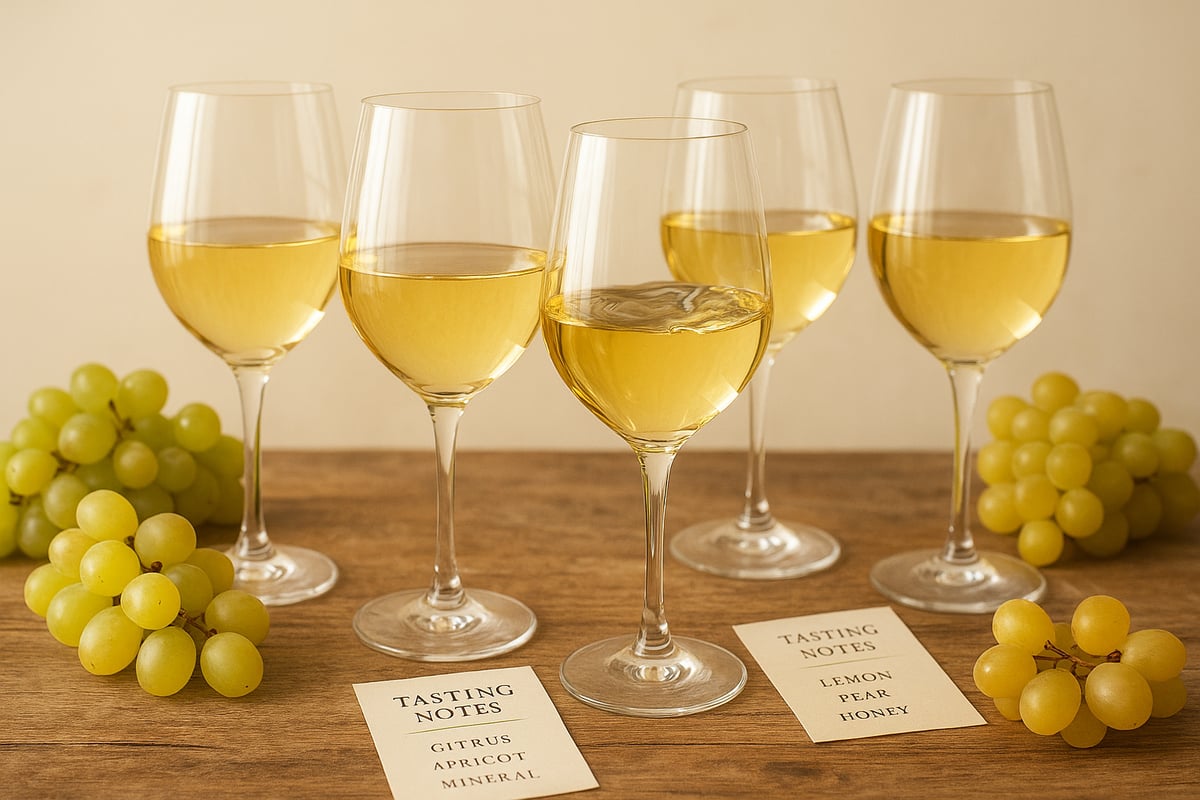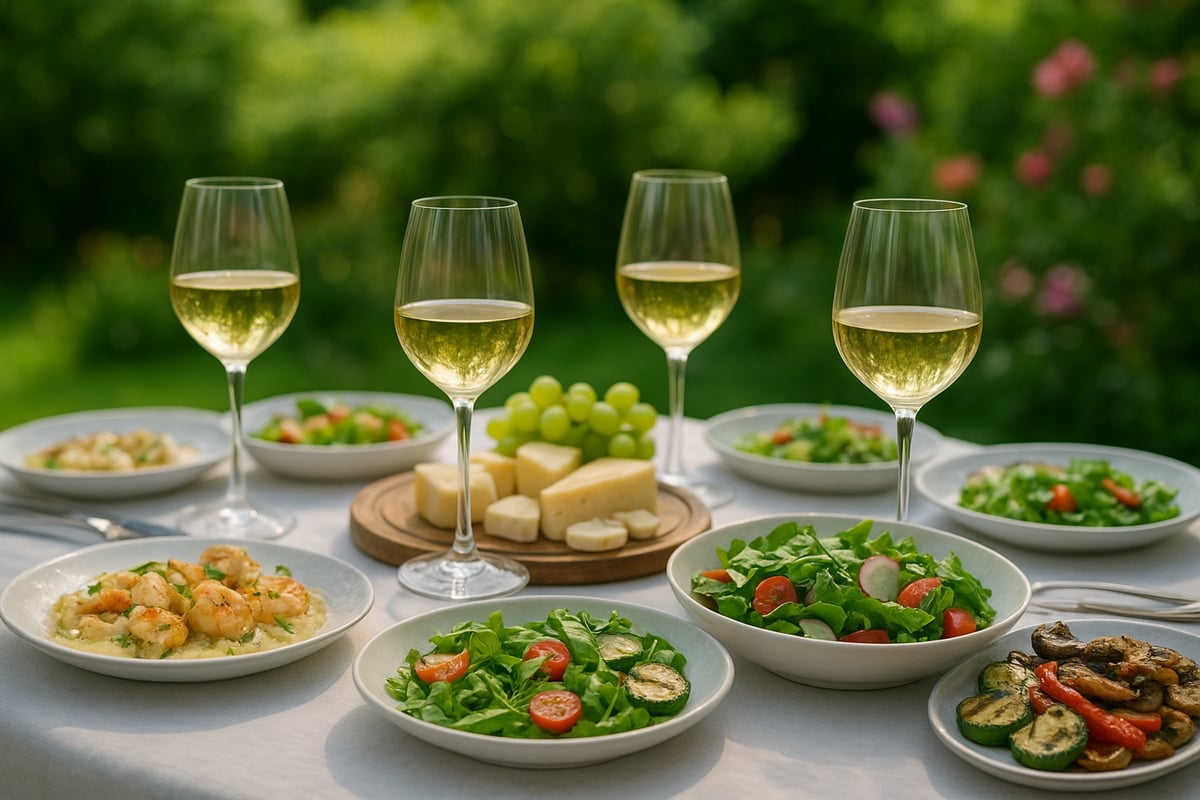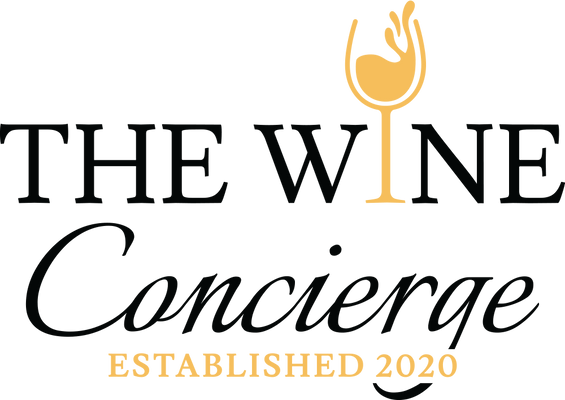White Wine Guide: Expert Insights and Pairings 2025
The world of white wine is buzzing with fresh energy and innovation, capturing the attention of both seasoned enthusiasts and curious newcomers. As tastes evolve and new regions emerge, white wine has become a vibrant part of modern wine culture, offering endless styles and experiences to discover.
In this guide, you'll uncover expert insights into white wine varieties, the latest winemaking techniques, and creative food pairings tailored for 2025. Dive into the essentials, from understanding what sets white wines apart to exploring top varietals, regional influences, and tips for elevating every glass.
Ready to unlock the diversity of white wine, find perfect pairings, and take your wine journey to the next level? Let’s get started.
Understanding White Wine: Fundamentals and Flavor Profiles
Curious what makes white wine so distinct and beloved across the globe? Let’s peel back the layers and discover why this style is capturing the hearts of wine lovers in 2025.

What Defines White Wine?
White wine is crafted primarily from green or yellow-skinned grapes, with minimal skin contact during production. This process preserves the clarity and pale color, ranging from light straw to deep gold.
Key characteristics include:
- Light to medium body
- Higher acidity compared to reds
- Flavor spectrum from bone-dry to sweet
Unlike their red and rosé counterparts, white wines are typically not fermented with grape skins, resulting in a more delicate structure. For example, compare the structure of Chardonnay (white) with Cabernet Sauvignon (red)—Chardonnay is often lighter, with more acidity and less tannin.
The grape variety and winemaking style play a huge role in shaping the final wine. Don’t be fooled by the myth that white wine is “simple.” Its diversity is vast, as you’ll see in this white wine overview, with styles ranging from crisp and refreshing to rich and complex.
Major White Wine Varietals and Their Profiles
When it comes to white wine, specific varietals stand out for their popularity and character. Leading grapes include:
- Chardonnay: Apple, citrus, sometimes buttery or oaky
- Sauvignon Blanc: Zesty citrus, grassy, often mineral
- Riesling: Ranges from bone-dry to sweet, with stone fruit, floral, or petrol notes
- Pinot Grigio: Crisp, pear, melon, subtle floral hints
- Chenin Blanc: Versatile, with notes from green apple to honey
Don’t overlook lesser-known stars like Albariño, Grüner Veltliner, or Viognier, which offer distinctive aromas and flavors—think orchard fruits, white flowers, or savory herbs.
The sweetness spectrum in white wine is broad. For instance, Riesling can be bone-dry or lusciously sweet, depending on where and how it’s made. Climate and terroir also shape the flavor: cooler regions often create zippier, more acidic profiles, while warmer areas bring out richer, riper fruit.
Chardonnay and Sauvignon Blanc remain top-selling varietals in both the US and Europe, but adventurous drinkers are increasingly exploring new grapes and regions.
The Structure of White Wine: Acidity, Body, and Aromatics
The secret to white wine’s food-friendliness lies in its structure. Acidity brings a refreshing, mouthwatering quality that makes these wines ideal partners for a wide range of dishes.
Body can range from feather-light (like a summer Pinot Grigio) to creamy and full (think oaked Chardonnay). Aromatic intensity is another hallmark, with profiles spanning floral, fruity, and mineral-driven notes.
Oak influence is a key differentiator. An unoaked Chardonnay is bright and citrusy, while an oaked version is richer and layered with vanilla or spice. This structural diversity means white wine doesn’t just play a supporting role at the table—it often steals the show.
Consumer trends point to growing love for lighter, high-acid white wines, as seen in recent product filter data. Next time you sip, notice how structure guides your pairing choices and elevates your tasting experience.
White Wine Winemaking: Techniques and 2025 Trends
White wine production is an art, a science, and a little bit of magic. Each bottle of white wine represents a blend of tradition and innovation, where every decision in the vineyard and winery shapes the final flavor. Let’s dive into how today’s top white wines are crafted and the trends redefining what’s in your glass for 2025.
The White Winemaking Process Step-by-Step
The journey of white wine begins in the vineyard, where timing is everything. Winemakers carefully monitor grape ripeness, harvesting at the exact moment acidity and sugar reach perfect balance. Once picked, grapes are quickly transported for gentle crushing and pressing. This step minimizes skin contact, keeping the wine bright, fresh, and light in color.
Next comes fermentation. Winemakers often use cool temperatures to preserve delicate aromas and flavors. Stainless steel tanks highlight crispness and fruit purity, while oak barrels can add creamy texture and subtle spice. For example, a stainless steel-fermented Sauvignon Blanc bursts with zesty citrus, while a barrel-aged Chardonnay offers richer, toastier notes.
After fermentation, aging choices further define each white wine—some rest in concrete eggs for complexity, others in barrels or tanks for months. Clarification ensures clarity and stability before bottling. Every step, from grape to glass, influences the texture, aroma, and style of white wine, making the winemaker’s decisions crucial to the final experience.
Innovations and Trends in White Wine for 2025
The world of white wine is evolving fast. Sustainability is now a core value, with more vineyards converting to organic and biodynamic practices. Low-intervention and natural winemaking are on the rise, letting the grape and terroir shine with minimal additives. Consumers are also exploring lesser-known varietals like Fiano and Carricante, broadening their palates beyond the classics.
Technology is playing a bigger role than ever. Advanced vineyard sensors, precise fermentation controls, and even artificial intelligence are helping winemakers create better, more consistent white wine with a lighter environmental footprint.
New Zealand’s Sauvignon Blanc remains a global trendsetter, yet the spotlight is shifting to boutique producers and diverse regions. The demand for organic, BIPOC-produced, and women-led white wine continues to grow, reflecting a more inclusive and eco-conscious wine culture. Expect to see even more exciting bottles and stories in 2025.
The Role of Terroir: How Region Shapes White Wine
Terroir is the soul of white wine. This French term sums up the unique combination of soil, climate, and topography that gives every region its signature style. For example, Burgundy’s limestone soils and cool climate produce elegant, mineral-driven Chardonnay, while California’s sunshine yields richer, fruitier expressions.
Old World regions like France, Germany, and Spain emphasize subtlety and tradition. New World areas such as California, New Zealand, and South Africa celebrate bold flavors and innovation. The same grape—say, Riesling—can taste dramatically different from Mosel’s slate slopes compared to Australia’s sun-soaked valleys.
Microclimates and vineyard practices further influence white wine character. Some regions are known for crisp, high-acid whites, while others are known for rounder, fuller-bodied styles. Recent sales data show growing consumer interest in both classic and emerging terroirs, underscoring the region's enduring power in the world of white wine.
Exploring the World’s Top White Wines and Regions
The world of white wine is a vibrant tapestry, woven with tradition, innovation, and discovery. Travelers and enthusiasts alike are captivated by the diversity of flavors, aromas, and stories found in every glass. Are you ready to explore the classic strongholds and bold new frontiers shaping the landscape of white wine in 2025?
Classic and Emerging White Wine Regions
Wine white wine owes much of its character to the regions where it is born. France remains a beacon, with Burgundy producing world-renowned Chardonnay and the Loire Valley offering vibrant Sauvignon Blanc and Chenin Blanc. Alsace, nestled along the German border, delivers aromatic Riesling and Pinot Gris.
Italy charms with Veneto’s crisp Pinot Grigio, Friuli’s distinctive Friulano, and Campania’s expressive Fiano. Germany’s Mosel and Rheingau are celebrated for their steep-slope Rieslings, which balance dazzling acidity with layered fruit. Spain’s Rías Baixas is the homeland of Albariño, a zesty, seafood-loving grape, while Rueda crafts lively Verdejo.
The New World continues to make waves. California and Oregon produce Chardonnay and Pinot Gris with unique personalities, while New Zealand’s Marlborough set a global standard for Sauvignon Blanc. Australia’s Margaret River and South Africa’s Western Cape shine with innovative takes on classic styles.
Here’s a quick snapshot:
| Region | Signature Varietals | Style Highlights |
|---|---|---|
| Burgundy | Chardonnay | Elegant, mineral, age-worthy |
| Marlborough | Sauvignon Blanc | Zesty, tropical, aromatic |
| Mosel | Riesling | Crisp, floral, age-worthy |
| Napa Valley | Chardonnay, Sauvignon Blanc | Bold, ripe, oaked/un-oaked |
| Rías Baixas | Albariño | Fresh, saline, citrusy |
As climate and terroir continue to evolve, so does the story of white wine. Emerging regions and microclimates offer new adventures for every palate.
Iconic White Wines to Try in 2025
In 2025, white wine lovers are spoiled for choice with both classic benchmarks and thrilling discoveries. Chablis Premier Cru from Burgundy offers a pure, steely expression of Chardonnay, while Napa Valley Chardonnay brings richness and depth. Marlborough Sauvignon Blanc dazzles with its vibrant aromatics, and Mosel Riesling’s versatility spans bone-dry to lusciously sweet styles.
Adventurous drinkers are seeking out Greek Assyrtiko, which boasts volcanic minerality, and Hungarian Furmint, famed for its role in Tokaji. South African Chenin Blanc is on the rise, showing both freshness and complexity.
Some must-try bottles for 2025 include:
- Alain Jaume - Grand Veneur Cotes du Rhone Blanc AOC (France)
- Eva Pemper Sauvignon Blanc (New Zealand)
- Steinmetz Mosel Wintricher Geierslay Trocken Riesling, Mosel-Saar-Ruwer (Germany)
- Monemvasia Assyrtiko, Laconia PGI (Greece)
- HER Collection Chenin Blanc (South Africa)
Trends show increased demand for indigenous and rare varietals. According to WineOnSale and Wine Access, the top-selling white wine by region continues to shift, with consumers craving authenticity and unique flavor profiles.
Notable Producers and Winemakers to Watch
Behind every great white wine is a visionary producer. Alain Jaume in Burgundy is a benchmark for Chardonnay, while Eva Pemper Marlborough Sauvignon Blanc on the map. Germany’s Steinmetz crafts Riesling with both tradition and innovation.
Diversity is flourishing. Women and BIPOC winemakers are gaining well-deserved recognition, bringing new perspectives to white wine. Boutique producers, often spotlighted by The Wine Concierge, are making waves with small-batch, expressive wines.
Recent awards and critical acclaim highlight the growing market share for diverse and boutique estates. The influence of a winemaker’s philosophy is more apparent than ever, with sustainability and authenticity at the forefront.
The Wine Concierge: Curated Diversity in White Wine
The Wine Concierge is redefining the wine experience by curating selections from women, BIPOC, and culturally diverse producers. Their specialty collections and quarterly wine club, Shades of Vino, spotlight boutique and underrepresented winemakers.

Each wine is handpicked for quality and diversity, offering options far beyond mainstream shelves. Educational guides, pairing resources, and community events encourage exploration and connection.
Purchases support The Black Winemakers Scholarship Fund, making every bottle part of a larger movement. Discovering new white wine favorites is as easy as joining a tasting or exploring a curated bundle.
Expert Food Pairings: Elevate Your White Wine Experience
Pairing food with white wine is an art that transforms both the meal and the glass. The right match can highlight subtle flavors, create balance, and even surprise your palate. With a few expert tips, you can elevate any dining experience, whether you are opening a favorite bottle or exploring something new.

White Wine and Food Pairing Principles
Great pairings start with understanding a few essential rules. First, match the intensity of your dish to the body of your white wine. Lighter wines pair best with delicate flavors, while fuller-bodied options complement richer foods.
Acidity is a hallmark of white wine and works wonders with fatty or creamy dishes. For example, a crisp Sauvignon Blanc cuts through goat cheese, while a zesty Albariño brightens seafood. Sweetness in white wine can tame spicy foods, making off-dry Riesling a classic partner for Asian cuisine.
Oaked whites, like certain Chardonnays, bring notes of vanilla and toast that enhance roasted poultry or buttery sauces. Unoaked whites keep things fresh and mineral-driven, ideal for vegetables or salads. Flexibility is key—trust your taste buds and experiment.
For more inspiration, check out this White wine food pairing guide for detailed suggestions and flavor matches.
Pairing by Varietal: What Goes Best with Each Style
Every varietal of white wine has a personality that shines with specific foods. Here is a quick reference table to get you started:
| Varietal | Perfect Pairings |
|---|---|
| Chardonnay | Creamy sauces, lobster, roast chicken |
| Sauvignon Blanc | Goat cheese, salads, shellfish |
| Riesling | Spicy Asian dishes, pork, blue cheese |
| Pinot Grigio | Light fish, antipasti, summer veggies |
| Chenin Blanc | Curries, roasted pork, apple desserts |
| Albariño | Tapas, seafood, fresh salads |
Classic pairings like Sauvignon Blanc with tangy goat cheese never go out of style. Modern twists, such as Pinot Grigio with grilled vegetables, keep things interesting. If you are a cheese lover, our Cheese and Wine Pairings Guide offers more creative ideas to enjoy white wine with your favorite wedges.
Pairing by Occasion: Everyday Meals to Special Events
White wine fits seamlessly into any occasion, from relaxed weeknights to festive gatherings. For quick dinners, Pinot Grigio is a go-to with grilled chicken or simple pasta. Sauvignon Blanc adds zip to salads and light appetizers.
When entertaining, sparkling whites make a lively start for guests, and a rich Chardonnay can anchor your main course. Holidays call for versatile wines—Riesling pairs beautifully with turkey, while Chenin Blanc is a crowd-pleaser with ham.
Outdoor dining? Albariño or Vermentino is a refreshing choice for picnics, seafood boils, and sunny afternoons. Curated wine bundles can simplify planning for themed events and ensure your white wine selections shine.
Seasonal Pairings: Spring, Summer, Fall, and Winter
Let the seasons inspire your white wine choices. In spring, reach for Sauvignon Blanc with fresh greens or Grüner Veltliner with asparagus. Summer is perfect for rosé-style whites and Pinot Grigio alongside seafood feasts.
As autumn arrives, oaked Chardonnay complements roasted vegetables and savory squash. Winter brings more affluent whites to the table—think Viognier with hearty stews or late-harvest Riesling with creamy desserts.
Seasonal wine club selections and changing menus keep your wine experience exciting all year. Watch for seasonal spikes in white wine sales as people match bottles to the flavors of the moment.
How to Choose, Serve, and Store White Wine Like a Pro
Unlocking the full potential of white wine starts well before you pour your first glass. From choosing the perfect bottle to serving with style and storing for future enjoyment, every step matters. Let’s break down the pro tips that make every sip of white wine a standout experience.
Selecting the Right White Wine for Your Taste and Budget
Navigating the world of white wine can be both thrilling and overwhelming. Start by reading labels for clues: grape variety, region, and tasting notes. If you’re unsure about your preferences, try interactive tools like the Wine quiz: Drink what you like to discover bottles that match your unique palate.
Explore beyond the classics. Italian Pinot Grigio under $15 or a South African Chenin Blanc can offer great value. Consider occasion and food pairings when making your choice. Price isn’t always a marker of quality in wine white wine, so trust your taste and seek recommendations from experts or friends.
Keep an open mind and let your curiosity guide you. The adventure in wine white wine is all about finding what makes your taste buds sing.
Proper Serving Temperatures and Glassware
Serving white wine at the right temperature brings out the best aromas and flavors. Too cold, and subtle notes are masked. Too warm, and the wine may taste flat or unbalanced. Check out this quick reference table for guidance:
| White Wine Style | Ideal Temp (°F) | Best Glass Shape |
|---|---|---|
| Crisp & Light (Sauv Blanc, Pinot Grigio) | 45–50 | Tulip or universal |
| Full & Oaky (Chardonnay) | 50–55 | Larger bowl, tapered |
| Aromatic (Riesling, Gewürztraminer) | 45–50 | Narrow, tulip-shaped |
Chill white wine in the fridge for a couple of hours before serving, or use an ice bucket for a quick fix. Choose glassware that allows aromas to concentrate—tulip glasses are a classic choice. Investing in the right tools can make your white wine moments shine.
Storing and Aging White Wine
Proper storage is the secret to keeping white wine fresh and flavorful. Most bottles are best enjoyed young, within a year or two of release. However, certain styles, like Burgundy Chardonnay or German Riesling, can evolve beautifully with a few years of age.
Follow these storage tips for white wine:
- Store bottles on their side in a cool, dark place.
- Maintain a consistent temperature (ideally 50–55°F).
- Protect from direct sunlight and vibration.
- Humidity should be moderate to prevent corks from drying out.
Everyday white wine is typically made for early enjoyment, while collectible bottles deserve a dedicated wine fridge or cellar. Knowing which wines benefit from aging helps you plan when to open or hold on to that special bottle.
Expert Tips for Enjoying White Wine to the Fullest
Elevate your white wine experience with a few expert practices. Decanting is not just for reds; some white wines, especially aged or oaked styles, benefit from a bit of air. Experiment with food pairings and consider hosting tasting flights to compare different regions or varietals.
Take notes as you taste. Use resources like Wine tasting notes and tips to sharpen your palate and remember your favorites. Join wine clubs or attend local tastings to broaden your horizons and keep your wine journey both educational and fun.
Remember, wine enjoyment is a journey. Keep exploring, tasting, and learning—every glass of white wine brings a new story to savor.
After exploring the world of white wine—from crisp Sauvignon Blanc and elegant Chardonnay to the unique gems made by diverse winemakers—you’re probably itching to taste something new, right? Imagine expanding your palate and supporting women and BIPOC wine professionals with every pour. Whether you’re just starting out or ready to discover your new favorite bottle, you don’t have to wait for a special occasion. Let’s turn your curiosity into a delicious adventure! Browse our expertly curated collection and uncover white wines that truly reflect the spirit of inclusion and discovery. Ready to explore? Shop The Wine Concierge White Wines


Leave a comment
Please note, comments must be approved before they are published